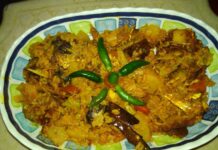The orient is an exotic heaven to the traveler from the west, even if that be just west of the Bay of Bengal. Sights sounds and culture of the orient is an exquisite experience not just to the westerner but also to a person from say India. Amidst the orient nestled under the Chinese mainland and between the south china sea and gulf of Tonkin is the nation of Vietnam. The land of the legendary Ho Chi Minh. If you take a stroll through the streets of Hanoi or Saigon, you will see stalls selling the national dish of Vietnam- Pho. Essentially a broth made from beef bones, rice noodles, herbs, meat, and garnishings. A portion of healthy food in a bowl, the taste is enhanced not just by the herbs and garnishing but also by the addition of the sauces that are usually served tableside in Pho restaurants,
The Pho is believed to have originated in the early 20th century under the French colonization there. However, villagers of Van Cu, talk of having Pho from before the French colonization period. Initially, the pho was believed to be sold at dawn and dusk by street vendors who would carry a cabinet carrying a cauldron over a wood fire, and another cabinet with the noodles, spices, and cookware over a wooden pole. This was called the ganh pho. There is another thought, which believes Pho which is pronounced as “fuh” comes from the French word feu, from the French dish pot-au-feu. The pot-au-feu is a common beef stew not unlike the broth of the pho, and essentially means “pot on the fire”. The pho was initially more popular in northern Vietnam and was a more bland affair, where the garnishings and herbs and spices were not so prevalent. With the partition of Vietnam, refugees spewed into South Vietnam, bringing the pho with them and popularising the same in South Vietnam. The pho now was made with an assortment of garnishings, herbs, and spices. Post the Vietnam war, as refugees spread globally, so also the pho spread with restaurants coming up across the globe. The original pho from North Vietnam was called the pho bac, while the spicier cousin from down south came to be known as pho nam. Though traditionally the dish was made from beef and called pho bo, variants with chicken called pho ga and the pho chay which is a vegetarian variety are also popular. It is to be noted that this is distinctly different from its Japanese cousin the Ramen, where the noodles are made of wheat, while in the pho the noodles are made from rice.
So let us raid the pantry to get our pho cooking. The ideal pho is made of beef and our variant today will also be of the same. Since the broth is essentially made by stewing beef bones, beef knuckles and the leg bones with high marrow content make the ideal bones for the broth.
To make the broth, ingredients needed are:
- Beef bones 2.5 kg
- Onions 2 medium
- Fresh ginger 5-inch piece
- Cinnamon 2 sticks
- Coriander seeds 1tbsp
- Fennel seeds 1 tbsp
- Star anise 6-7
- Whole cloves 6-7
- Cardamom pod 1
- Salt to taste
- Fish sauce ¼ cup
- Yellow rock sugar
- Salt to taste
- Water (about 5 liters)
For the assembly and serving we will need:
- Rice noodles 500 gms
- Sirloin steak 250 gms
- Onion 1 small
- Cilantro leaves one sprig finely chopped
- Mint/Thai basil 2 sprigs
- Mung bean sprouts
- Red chilies few
- Lime wedge 1
- Fish sauce dipping quantity
- Hoisin sauce dipping quantity
Now that we have all the ingredients ready let us roll our sleeves and get going on the cook. To start off we will boil the rice noodles in a pot, strain them and add cold water onto the noodles immediately in a colander so that the noodles don’t stick to each other. After straining it again we will set it aside. The medium onions we will quarter and set aside for the broth and the small onion we will chop into small pieces and set aside for the assembly. The sirloin is sliced into thin slices along the grain and set aside, while the ginger is halved. We are now ready to get cooking after the prep is done.
Making the broth
To a large stockpot we add the beef bones and cover with water, and then raise them to a boil over high heat. This will clean the bones, and we will throw away the water and used the cleaned bones now. We put the bones back in the pot filled with water over high heat till the water reaches a boil while we get the other ingredients ready. Meanwhile, on a baking sheet, we line it with aluminium foil and broil the quartered onion and halved ginger for 10 minutes on high heat. Occasionally they are turned till they become charred and browned on all sides. The spices, i.e. the star anise, coriander, and fennel seeds, the cinnamon stick the clove, and black cardamom pods are meanwhile roasted on a dry frying pan for about 5 minutes on low heat till the fragrance starts coming out, at which time they are taken and placed in a muslin bag or a cheesecloth and tied up and set aside. The parboiled bones should be on a boil by now. The heat is lowered to simmer and the charred onion and ginger as also the spice bag are now added to the water in the stockpot. Salt to taste is added along with the fish sauce and the rock sugar. This is now allowed to simmer for 3 to 4 hours. If any scum or foam rises up that is removed using a spoon. This slowly infuses the spices and the flavor from the charred onions and ginger along with flavors of beef bones into the broth The bones, the charred onion, and ginger are then removed using tongs and the broth is strained through a fine-mesh strainer. The layer of fat is then skimmed off using a spoon. If we do not plan to use the broth immediately it can be stored in containers and refrigerated. As the broth cools, the fat will solidify and then can be easily removed.
Assembling the Pho
Now that the broth is ready, it is kept on a simmer. The noodles we have set aside are now taken in bowls filling it 1/3rd with the noodles. The broth we have made will serve about 6 servings. The meat slices of the steak are now arranged on the noodles following which it is topped with the hot broth and the chopped cilantro. This is now ready to go on the table. To serve, a bowl with the garnishes mentioned above and sauces are served together. To enjoy the pho, we add aromatic herbs like basil or mint first to the pho, so that the herb flavors infuse into the broth. After a minute of allowing this, the mung bean sprouts and chilies are added to add their texture into the broth. Lastly, the sauces of our choice and as per our taste is added into it and mixed. A dash of lime and the Pho is now ready to be consumed.
While we have used beef sticks and beef to make our pho today, chicken bones and chicken breast can also be used while making pho. The sauce combination is completely up to our taste preference, and the spicier the appetite more the sauces be added. Since the meat is raw, it is advised that the broth when it is added be really hot.
The pho is an easy-to-fix meal, but the real test is in making the broth. In fact, the pho bac of north Vietnam is specially said to emphasize on the broth instead of the garnishing, spices, and sauces. Also, this would be a healthy meal taking care of all nutrient requirements. The serving that we made would for example give us 436 calories worth of energy, would have adequate protein carbs, and fats. It would also have dietary fibers from the garnishings while cholesterol would be about 20 gms. The trick in making a good pho is to make the broth right, for which it’s essential to simmer the broth over a low fire for a substantial amount of time as we did. The longer the simmer, the better the tastes that come out from the bones, making the broth whole-bodied. My mother’s special ingredients thus become very critical in making this Vietnamese specialty. A big smile dollops of patience and huge helpings of love all mix well in the broth when you are making and serving the pho. Bon Appetit.






